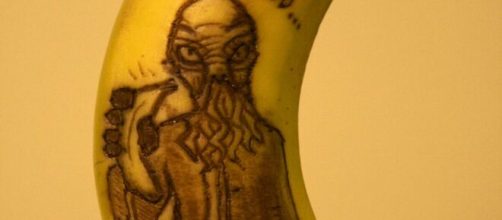How do you become a famous artist? Be original, right? Do something no one else does. After all, that’s how Andy Warhol made it. (More about that in a moment).
Key to success
Artsy.net reports a study showing that originality has nothing to do with success. Instead, artists get to be household names through their friends. (More about that in a moment, too).
But wait, the Washington Post reports a different road to achievement in the art world: boredom. Anna Chojnicka, bored silly while sequestered during the pandemic, made art by mindlessly bruising bananas.
The upshot? “Now she has an international following,” the Post says. See? Easy peasy.
Birth of banana art
Chojnicka, whose day job is helping local businesses focus on environmental issues, got her banana art idea when locked down in her London flat. Idle and restless, she “absent-mindedly” ran a fork on the peel of a banana and saw the marking grow darker like an ink drawing. Absorbed by that, she began sketching on the peel and posting her effort each day on Twitter and Instagram. Now, the Post says, “she has thousands of followers.”
Her banana art imagery ranges from simple cartoons to meticulously detailed portraits. She has had such an impact that she’s appeared on local TV stations and was featured in a 60-second documentary on YouTube.
By popular demand, she also gives online classes on making banana art.
Making headlines
Banana art also made Newsday with a story headlined “Coronavirus leads to ‘Banana Art’” While acknowledging that the quarantine led people to develop unusual talents, Newsday called her way the “most unique.”
Birth of soup can art
Of course, when you think about it, Chojnick’s banana art isn’t all that far from Warhol’s soup cans, except that her art was her own idea and his art wasn’t. He got the idea from his friend, interior designer Muriel Latow. This was documented in a Warhol biography by Victor Bockris in London, 1989.
According to Bockris, Warhol, a rank-and-file commercial artist at the time, told Latow he wanted an idea that would have "a lot of impact," but differ from the work of successful Pop artists like Roy Lichtenstein and James Rosenquist.
“I don’t know what to do! Muriel, you’ve got fabulous ideas. Can’t you give me an idea"? Warhol said. Muriel Latow came through, telling him to paint something that everybody knows, like cans of soup. The rest is history.
So, it’s who you know
So, yes, originality serves, but Artsy’s report that artists making it big through their friends also plays a role. (Muriel Latow take a bow). But the study Arsty refers to makes clear that it’s not originality, but rather artists' friends who help them make it.
The study, conducted by Columbia Business School professor Paul Ingram, Ingram, and his colleague Mitali Banerjee, founds that artists with many connections were “most likely to be famous, regardless of how creative their art was.”
Talent doesn’t count
In fact, the study found the greatest predictor of fame for an artist was having a diverse network of friends. And get this: “if artists had high creativity scores, they were not necessarily famous.” This would account for all the starving artists we know.


